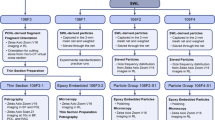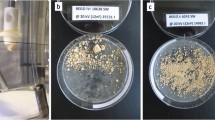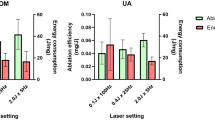Abstract
The objective of this study is to reveal the potential of micro scale hydrodynamic bubbly cavitation for the use of kidney stone treatment. Hydrodynamically generated cavitating bubbles were targeted to the surfaces of 18 kidney stone samples made of calcium oxalate, and their destructive effects were exploited in order to remove kidney stones in in vitro experiments. Phosphate buffered saline (PBS) solution was used as the working fluid under bubbly cavitating conditions in a 0.75 cm long micro probe of 147 μm inner diameter at 9790 kPa pressure. The surface of calcium oxalate type kidney stones were exposed to bubbly cavitation at room temperature for 5 to 30 min. The eroded kidney stones were visually analyzed with a high speed CCD camera and using SEM (scanning electron microscopy) techniques. The experiments showed that at a cavitation number of 0.017, hydrodynamic bubbly cavitation device could successfully erode stones with an erosion rate of 0.31 mg/min. It was also observed that the targeted application of the erosion with micro scale hydrodynamic cavitation may even cause the fracture of the kidney stones within a short time of 30 min. The proposed treatment method has proven to be an efficient instrument for destroying kidney stones.








Similar content being viewed by others
References
Brennen, C. E. Cavitation and Bubble Dynamics. London, UK: Oxford University Press, 1995.
Brennen, C. E. Fundamentals of Multiphase Flow. New York: Cambridge University Press, 2005.
Chong, X. Subsonic choked flow in the microchannel. Phys. Fluids 18:127104, 2006.
Coe, F. L., A. Evan, and E. Worcester. Kidney stone disease. J. Clin. Investig. 115:2598–2608, 2005.
Crowe, C. T. Multiphase Flow Handbook. Boca Raton, FL: CRC Press, 2006.
Dales, L. G., G. D. Friedman, E. M. Hunkeler, and R. A. Hiatt. Frequency of urolithiasis in a prepaid medical care program. Am. J. Epidemiol. 115:255–265, 1982.
DiSario, J., R. Chuttani, J. Croffie, et al. Flow visualization of cavitating flows through a rectangular slot micro-orifice ingrained in a microchannel. Gastrointest. Endosc. 65:750–756, 2007.
Eisenberg, P. Cavitation Damage, Hydronautics. Incorporated Washington, DC, AD No. 602833, 1963.
Evan, A. P. Physiopathology and etiology of stone formation in the kidney and the urinary tract. Pediatr. Nephrol. J. 25:831–841, 2010.
Evan, A. P., and J. A. McAteer. Q-effects of shock wave lithotripsy. In: Kidney Stones: Medical and Surgical Management, Chap. 23, edited by F. L. Coe, M. J. Favus, C. Y. C. Pak, J. H. Parks, and G. M. Preminger. Philadelphia: Lippincott-Raven, 1996, pp. 549–560.
Evan, A. P., and L. R. Willis. Extracorporeal shock wave lithotripsy: complications. In: Smith’s Textbook on Endourology, Chap. 41, edited by A. D. Smith, G. H. Badlani, D. H. Bagley, R. V. Clayman, and S. G. Docimo. Hamilton, ON: Decker, Inc., 2007, pp. 353–365.
Evan, A. P., L. R. Willis, J. E. Lingeman, et al. Renal trauma and the risk of long-term complications in shock wave lithotripsy. Nephron 78:1–8, 1998.
Heimbach, D., R. Munver, P. Zhong, J. Jacobs, A. Hesse, S. C. Mülles, and G. M. Preminger. Acoustic and mechanical properties of artificial stones in comparison to natural kidney stones. J. Urol. 164:537–544, 2000.
Koşar, A., M. Şeşen, O. Oral, Z. Itah, and D. Gozuacik. Bubbly cavitating flow generation and investigation of its erosional nature for biomedical applications. IEEE Trans. Biomed. Eng. 58:1337–1346, 2011.
McAteer, J. A., and A. P. Evan. The acute and long-term adverse effects of shock wave lithotripsy. Semin. Nephrol. 28:200, 2008.
Mishra, C., and Y. Peles. Flow visualization of cavitating flows through a rectangular slot micro-orifice ingrained in a microchannel. Phys. Fluids 17:113602–113615, 2005.
Sheldon, G. L., and L. Finnie. The mechanism of material removal in the erosive cutting of brittle materials. ASME J. Eng. Ind. 88B:393–400, 1966.
Singh, S. K., M. M. Agarwal, and S. Sharma. Medical therapy for calculus disease. Br. J. Urol. Int. 107:356–368, 2010.
Skim, S., K. J. Lee, and Y. Seo. Polyetheretherketone (PEEK) surface functionalization by low-energy ion-beam irradiation under a reactive O2 environment and its effect on the PEEK/Copper adhesives. Langmuir 20:157–163, 2004.
Tan, E. C., K. H. Tung, R. Kwok, and K. T. Foo. Percutaneous ultrasonic lithotripsy—its role in the management of renal and upper ureteric stones. Singap. Med. J. 30:45–47, 1989.
Wilson, D. M., W. M. O’Fallon, R. S. Malek, L. T. Kurland, and C. M. Johnson. Renal stone epidemiology: a 25-year study in Rochester, Minnesota. Kidney Int. J. 16:624–631, 1979.
Acknowledgments
This work was supported by Sabancı University Internal Grant for Research Program under Grant IACF09-00642 and TUBITAK (The Scientific and Technological Research Council of Turkey) Support Program for Scientific and Technological Research Projects Grant, 111M621. Devrim Gozuacik is a recipient of “EMBO” Strategical Development and Installation Grant. The authors would like to thank Prof. M. A. Gulgun (Sabanci University) and M. Tosun (Ecole Polytechnique Federale de Lausanne) for their help in analysis of kidney stones. They are also thankful to Prof. Hakkı Perk from Demetevler Oncology Hospital for providing kidney stone samples. Undergraduate and graduate student support from Faculty of Natural Sciences and Engineering of Sabancı University and equipment utilization support from Sabanci University Nanotechnology Research and Applications Center (SUNUM) is also gratefully appreciated.
Author information
Authors and Affiliations
Corresponding author
Additional information
Associate Editor Kerry Hourigan oversaw the review of this article.
Rights and permissions
About this article
Cite this article
Perk, O.Y., Şeşen, M., Gozuacik, D. et al. Kidney Stone Erosion by Micro Scale Hydrodynamic Cavitation and Consequent Kidney Stone Treatment. Ann Biomed Eng 40, 1895–1902 (2012). https://doi.org/10.1007/s10439-012-0559-7
Received:
Accepted:
Published:
Issue Date:
DOI: https://doi.org/10.1007/s10439-012-0559-7




